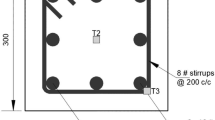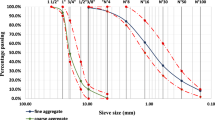Abstract
This paper investigates the effect of basalt fibres on the performance of concrete and is designed for applications in flooring and pavement construction. A total of seven concrete mixtures were prepared using various lengths of chopped basalt fibres (12 mm, 36 mm and 50 mm length) with two dosages of 4 kg/m3 and 8 kg/m3, respectively. In order to evaluate the performance of these mixtures for these specified applications, the mechanical properties and durability related to the intended application were examined. The investigation of these mechanical properties directly correlates to the compressive strength and flexural strength of the basalt-reinforced concrete. The abrasion resistance, porosity, sorptivity and sorption of the mixtures were also evaluated to determine the durability and subsequent performance of the mixtures. An Ultrasonic Pulse Velocity test, a non-destructive test, was conducted to verify and validate the quality of the mixtures. Results from this study showed a significant increase in flexural strength and abrasion resistance of concrete when combined with basalt fibres, although a slight decrease in the compressive strength of concrete was observed. The introduction of basalt fibres also served to increase the permeability properties of these mixtures. However, this resulting permeability was found to be within an acceptable range for the designed application. Results from the Ultrasonic Pulse Velocity test and the subsequent validation of the results validated the viability of assessing the quality of concrete mixtures incorporating basalt fibres by employing this method of non-destructive testing.














Similar content being viewed by others
References
Booya E, Gorospe K, Adesina A, Das S (2019) Microscopic and absorption properties of modified pulp fibre reinforced cementitious composites. In: 17th Euroseminar on microscopy applied to building materials EMABM. Toronto, Canada, pp 128–133
Wang D, Ju Y, Shen H, Xu L (2019) Mechanical properties of high performance concrete reinforced with basalt fiber and polypropylene fiber. Constr Build Mater. https://doi.org/10.1016/j.conbuildmat.2018.11.181
Güneyisi E, Atewi YR, Hasan MF (2019) Fresh and rheological properties of glass fiber reinforced self-compacting concrete with nanosilica and fly ash blended. Build Mater Constr. https://doi.org/10.1016/j.conbuildmat.2019.03.087
Li W, Zhu JH, Chen P et al (2019) Evaluation of carbon fiber reinforced cementitious matrix as a recyclable strengthening material. J Clean Prod. https://doi.org/10.1016/j.jclepro.2019.01.256
Branston J, Das S, Kenno SY, Taylor C (2016) Influence of basalt fibres on free and restrained plastic shrinkage. Cem Concr Compos 74:182–190. https://doi.org/10.1016/j.cemconcomp.2016.10.004
Branston J, Das S, Kenno SY, Taylor C (2016) Mechanical behaviour of basalt fibre reinforced concrete. Constr Build Mater. https://doi.org/10.1016/j.conbuildmat.2016.08.009
Branston J, Booya E, Gorospe K et al (2019) Microstructure and mechanical properties of basalt fibre reinforced concrete. In: 17th Euroseminar on microscopy applied to building materials, Toronto, Canada, pp 121–127
Adesina A, Das S (2020) Development of eco-friendly basalt fibre reinforced cementitious composites using taguchi method. Silicon. https://doi.org/10.1007/s12633-020-00532-z
Adesina A, Das S (2019) Mechanical performance of engineered cementitious composites incorporating recycled glass powder. Can J Civ Eng. https://doi.org/10.1139/cjce-2019-0524
Adesina A, Das S (2020) Mechanical performance of engineered cementitious composite incorporating glass as aggregates. J Clean Prod. https://doi.org/10.1016/j.jclepro.2020.121113
Adesina A, Das S (2020) Performance of green fibre reinforced composite made with sodium carbonate activated slag as a binder. Innov Infrastruct Solut. https://doi.org/10.1007/s41062-020-00296-w
Sim J, Park C, Moon DY (2005) Characteristics of basalt fiber as a strengthening material for concrete structures. Compos Part B Eng. https://doi.org/10.1016/j.compositesb.2005.02.002
Duic J, Kenno S, Das S (2018) Flexural Rehabilitation and Strengthening of Concrete Beams with BFRP composite. J Compos Constr 22:04018016. https://doi.org/10.1061/(asce)cc.1943-5614.0000851
High C, Seliem HM, El-Safty A, Rizkalla SH (2015) Use of basalt fibers for concrete structures. Constr Build Mater. https://doi.org/10.1016/j.conbuildmat.2015.07.138
Černý M, Glogar P, Sucharda Z et al (2009) Partially pyrolyzed composites with basalt fibres: mechanical properties at laboratory and elevated temperatures. Compos Part A Appl Sci Manuf. https://doi.org/10.1016/j.compositesa.2009.08.002
Duic J, Branston J, Adesina A et al (2020) Field applications of basalt fiber materials for rehabilitation of deteriorated concrete structures. J Perform Constr Facil 34:1–10. https://doi.org/10.1061/(ASCE)CF.1943-5509.0001500
Bastani A, Adesina A, Das S, Lawn D (2020) Rehabilitation of steel I-beam with basalt fiber reinforced polymer. In: Structures congress 2020: selected papers from the structures congress
Hughes E, Adesina A, Paini B et al (2020) Strengthening of concrete beams with basalt fibre reinforced polymer. In: Structures congress 2020: selected papers from the structures congress
Iyer P, Kenno SY, Das S (2015) Mechanical properties of fiber-reinforced concrete made with basalt filament fibers. J Mater Civ Eng. https://doi.org/10.1061/(ASCE)MT.1943-5533.0001272
Papenfus N (2003) Applying concrete technology to abrasion resistance. In: Proceedings of 7th international conference on concrete block pavement, Sun City, South Africa. ISBN Number: 0-958-46091-4
Felekoǧlu B, Türkel S, Altuntaş Y (2007) Effects of steel fiber reinforcement on surface wear resistance of self-compacting repair mortars. Cem Concr Compos. https://doi.org/10.1016/j.cemconcomp.2006.12.010
Grdic ZJ, Curcic GAT, Ristic NS, Despotovic IM (2012) Abrasion resistance of concrete micro-reinforced with polypropylene fibers. Constr Build Mater. https://doi.org/10.1016/j.conbuildmat.2011.07.044
Kabay N (2014) Abrasion resistance and fracture energy of concretes with basalt fiber. Constr Build Mater. https://doi.org/10.1016/j.conbuildmat.2013.09.040
ASTM C39 (2016) Standard test method for compressive strength of cylindrical concrete specimens. Am Soc Test Mater. https://doi.org/10.1520/C0039_C0039M-20
ASTM C1609 (2013) Standard C1609/C1609M-12 “Flexural Performance of Fiber-Reinforced Concrete (Using Beam With Third-Point Loading).” Annu B ASTM Stand. https://doi.org/10.1520/C1609
ASTM C944/C944M (2012) Standard Test Method for Abrasion Resistance of Concrete or Mortar Surfaces by the Rotating-Cutter Method. ASTM Int. https://doi.org/10.1520/C0944
ASTM C 642-2006 (2006) Standard test method for density, absorption, and voids in hardened concrete. ASTM Int West Conshohocken, PA, pp 1–3. https://doi.org/10.1520/C0642-13.5
ASTM C1757 (2014) ASTM Standard C1757: standard test method for determination of one-point, bulk water sorption of dried concrete. ASTM Int. https://doi.org/10.1520/c1757-13
ASTM C1585 (2004) Standard test method for measurement of rate absorption of water by hydraulic-cement concretes. Annu B ASTM Stand 04:1–6. 10.1520/C1585-13.2
ASTM C597 (2016) Standard test method for pulse velocity through concrete ASTM C 597. ASTM Int. https://doi.org/10.1520/C0597-16.2
Acknowledgements
The authors would like to thank MEDA limited located in Windsor, ON, Canada, for the supplied basalt fibres and the technical assistance provided for this research.
Author information
Authors and Affiliations
Corresponding author
Ethics declarations
Conflict of interest
The authors declare that they have no conflict of interest.
Rights and permissions
About this article
Cite this article
Adesina, A., Bastani, A., Heydariha, J.Z. et al. Performance of basalt fibre-reinforced concrete for pavement and flooring applications. Innov. Infrastruct. Solut. 5, 103 (2020). https://doi.org/10.1007/s41062-020-00359-y
Received:
Accepted:
Published:
DOI: https://doi.org/10.1007/s41062-020-00359-y




